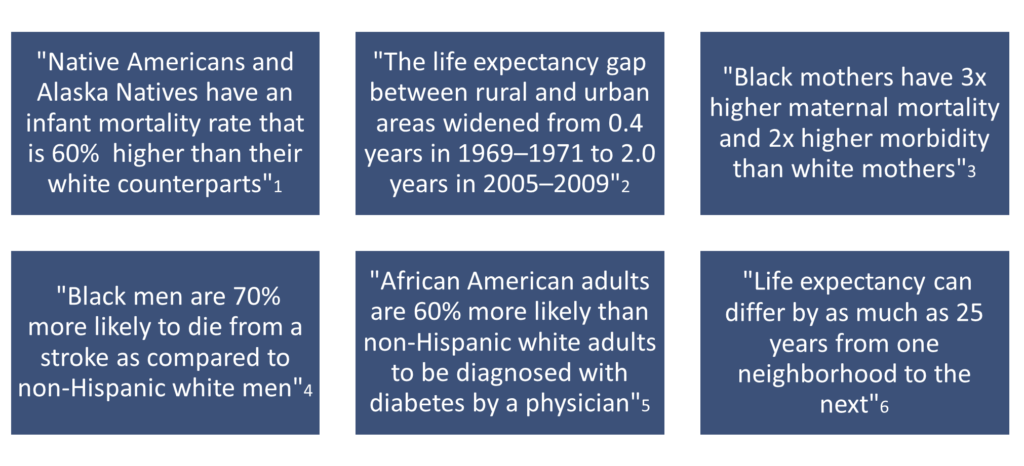Insight Paper August 26, 2021
Understanding Health Equity
How to define and what it means for the healthcare industry.
Health equity has become a major focus in the healthcare industry over the past two years, with not only an increase of attention, but actionable programs created by payers, providers, and various levels of government. Health equity has received so much attention that unfortunately it has become a buzzword sometimes used without full understanding of what health equity is and what health equity initiatives aim to accomplish. The intent of this paper is to clarify how health equity is defined and where the healthcare industry is moving in solving health disparities.
To define health equity, one first needs to understand health inequity. Health inequity is caused by health disparities, which are defined as any avoidable or unfair differences in health status between segments of the population. Individuals who face economic or social barriers to health based on their race, income level, geographical location, sex, age, culture, language, or education may suffer from health disparities. These health disparities can create areas of health inequity which can be seen in “differences in length of life; quality of life; rates of disease, disability, and death; severity of disease; and access to treatment.” For example, within the United States:

Sources: 3, 4, and 5 from BlueCross BlueShield at https://www.bcbs.com/the-health-of-america/healthequity/?utm_source=bcbscomhomepage; 1, 2, and 6 from the National Academies of Sciences, Engineering, and Medicine; Health and Medicine Division; Board on Population Health and Public Health Practice; Committee on Community-Based Solutions to Promote Health Equity in the United States; Baciu A, Negussie Y, Geller A, et al., editors.
Health inequity adds major costs for healthcare companies and the government. A health disparity study by the University of Minnesota found that preventable deaths caused by racial disparities cost the state $1.2 to $2.9 billion each year. In 2015, Dr. John Z. Ayanian, Director of the Institute for Healthcare Policy and Innovation at the University of Michigan, estimated that racial health disparities can be associated with an estimated $35 billion in excess health care expenditures, $10 billion in illness-related lost in productivity, and nearly $200 billion in premature deaths. For employers and health plans, Dr. Ayanian proposed that “reducing disparities in effective asthma treatment by 10% for African American workers could save more than $1,600 per person annually in medical expenses and costs of missed work.” To reduce and prevent costs associated with health disparities, advancing health equity is worth the initial investment by the healthcare industry.
Although there has been an increase of attention, health equity initiatives are not new and while the scope of the problem is massive, there is a solid foundation of work both by public and private organizations that can guide healthcare companies in promoting and acting on advancing health equity. Below I outline where the healthcare industry stands in advancing health equity and where it is headed by using a framework from the National Quality Forum.

Advancing health equity to resolve health disparities across the United States will continue to grow and first movers will benefit from cost savings, while their employees, members, customers, and the community at large will benefit from enhanced access to and quality of care. Whether your organization is interested in advancing health equity and not sure where to start or you have already kicked off a multi-year health equity program: Trexin’s capabilities and expertise can help you “get to done”.
Click here to learn more about our Health Equity Practice Area.
References
Health equity. Cigna. (n.d.). https://www.cigna.com/about-us/corporate-responsibility/report/health-and-well-being/health-equity.
Centers for Disease Control and Prevention. (2020, March 11). Health equity. https://www.cdc.gov/chronicdisease/healthequity/index.htm.
Nanney, M., Myers, S., Xu, M., Kent, K., Durfee, T., & Allen, M. (2019). The Economic Benefits of Reducing Racial Disparities in Health: The Case of Minnesota. International Journal of Environmental Research and Public Health, 16(5), 742. https://doi.org/10.3390/ijerph16050742.
Ayanian, J. Z. (2017, May 8). The Costs of Racial Disparities in Health Care. Harvard Business Review. https://hbr.org/2015/10/the-costs-of-racial-disparities-in-health-care.
National Quality Forum. (2017, September). A Roadmap for Promoting Health Equity and Eliminating Disparities: The Four I’s for Health Equity.

